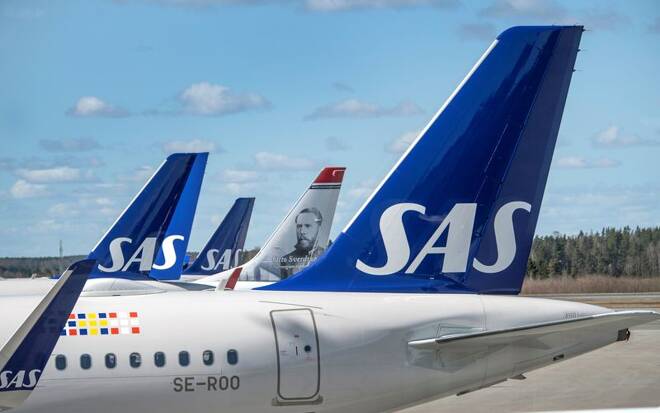Advertisement
Advertisement
Airline SAS Q2 loss narrows, hopes to raise $1 billion in new cash
By:
STOCKHOLM (Reuters) - Airline SAS reported on Tuesday a February-April loss that was smaller than an year ago and said it aimed to raise at least 9.5 billion Swedish crowns ($972 million) in new equity capital.
By Anna Ringstrom
STOCKHOLM (Reuters) -Airline SAS said it hopes to convert debt to equity and raise 9.5 billion Swedish crowns ($972 million) in new cash, warning of liquidity problems if it falls short as it posted a quarterly loss that was narrower than a year ago.
The carrier, part-owned by Sweden and Denmark, has been struggling for years and in February unveiled a major new restructuring plan that it said depended on raising then-unspecified new capital.
“In addition to reducing the cost structure and improving efficiencies, SAS is seeking to convert approximately SE 20 billion of debt and hybrid notes into common equity and will also seek to raise not less than SE 9.5 billion in new equity capital,” SAS said on Tuesday.
However, CEO Anko van der Werff told analysts on a call there had not been sufficient progress so far with the restructuring plans, and both governments declined to say whether they would pay up again after agreeing a 3-billion-crown rescue deal with the company in 2020.
SAS said discussions with stakeholders overall had made “limited progress,” and its shares were down 7% at 1015 GMT.
“In the event that the expected burden sharing, debt conversions, and new capital raise are not completed as planned, SAS will not be able to support its existing capital structure and current liquidity levels,” it said.
SAS reported a February-April loss before tax of 1.56 billion crowns against a year-earlier 2.33 billion loss.
The carrier was already struggling before the coronavirus pandemic amid high costs and increased competition. The aviation industry is now struggling to recover from COVID and SAS has reduced its summer programme by 4,000 of 75,000 planned flights.
“We are seeing healthy underlying demand, but uncertainty persists,” van der Werff said in a statement. “Traffic to and from Asia remains affected by remaining COVID-19 restrictions as well as the geopolitical situation.”
He told Reuters one key element for the rescue plan was to slash costs for aircraft leased for Asian routes which have stood unused, and that SAS may take lessors to court if ongoing negotiations were unfruitful.
“We don’t know when the Russian airspace is going to open again and we cannot pay for those aircraft because that will not allow us to attract investors. New investors will say ‘you have to clean up, otherwise we will not invest,” he said in an interview.
($1 = 9.7718 Swedish crowns)
(Reporting by Anna Ringstrom, additional reporting buy Helena Soderpalm, and Stine Jacobsen in Copenhagen; Editing by Simon Johnson, Kenneth Maxwell and Bernadette Baum)
About the Author
Reuterscontributor
Reuters, the news and media division of Thomson Reuters, is the world’s largest international multimedia news provider reaching more than one billion people every day. Reuters provides trusted business, financial, national, and international news to professionals via Thomson Reuters desktops, the world's media organizations, and directly to consumers at Reuters.com and via Reuters TV. Learn more about Thomson Reuters products:
Did you find this article useful?
Latest news and analysis
Advertisement
